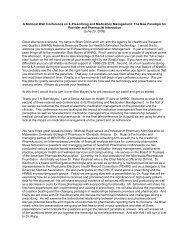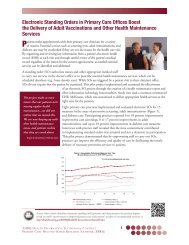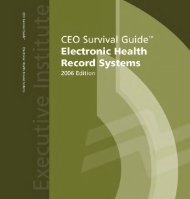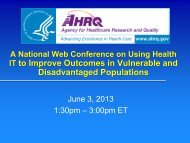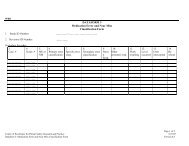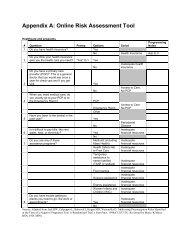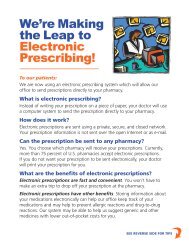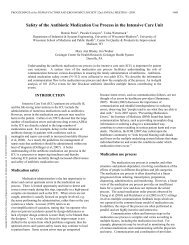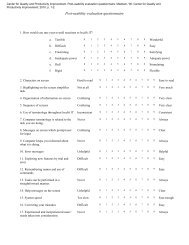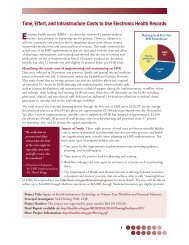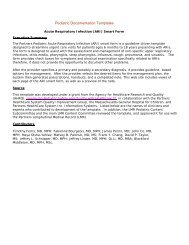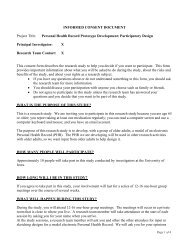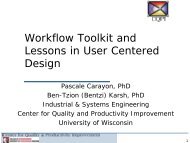Creating an Evidence Base for Vision Rehabilitation
Creating an Evidence Base for Vision Rehabilitation
Creating an Evidence Base for Vision Rehabilitation
Create successful ePaper yourself
Turn your PDF publications into a flip-book with our unique Google optimized e-Paper software.
Scope<br />
In the US 16.5 million people age 45 or older self-report some <strong>for</strong>m of vision impairment<br />
even when wearing glasses or contacts. (Lighthouse National Survey on <strong>Vision</strong> Loss, 1995). By<br />
2010, this figure will grow to 20 million. As the baby boomer generation ages, with people<br />
living longer <strong>an</strong>d <strong>an</strong> increase of conditions that cause vision loss, such as diabetes, the need <strong>for</strong><br />
quality vision rehabilitation services is critical in reducing the disabling effects of vision loss.<br />
Un<strong>for</strong>tunately, this field until recently lacked st<strong>an</strong>dardized measurement <strong>an</strong>d evaluation tools<br />
urging Lighthouse International (LHI), the lead agency on this project, to design <strong>an</strong>d build a<br />
software which would allow <strong>for</strong> st<strong>an</strong>dardized patient tracking, assessment <strong>an</strong>d evaluation,<br />
patient-centered intervention with goal setting, documentation of service delivery, <strong>an</strong>d outcomes<br />
measurement. The project involved the installation <strong>an</strong>d implementation of EVRR® at<br />
Lighthouse International, The Iris Network in Maine, <strong>an</strong>d the Central Association <strong>for</strong> the Blind<br />
<strong>an</strong>d Visually Impaired (CABVI) in Utica, New York representing urb<strong>an</strong>, suburb<strong>an</strong>, <strong>an</strong>d rural<br />
environments in two states.<br />
The activities necessary to carry out the project fell into four major areas:<br />
1. General program m<strong>an</strong>agement<br />
2. Best practice protocols<br />
3. Technical implementation<br />
4. Research <strong>an</strong>d evaluation<br />
General Program M<strong>an</strong>agement. General program m<strong>an</strong>agement activities included<br />
directing the team of Lighthouse staff <strong>an</strong>d consult<strong>an</strong>ts who supported all the collaborating<br />
particip<strong>an</strong>t org<strong>an</strong>izations, holding monthly partner meetings <strong>an</strong>d weekly subcommittee meetings<br />
to discuss implementation <strong>an</strong>d problems that arose as well as their proposed solutions<br />
Best Practice Protocols. Three major activities were involved in the development of bestpractice<br />
protocols. The first was the development of a training m<strong>an</strong>ual that integrated the use of<br />
best-practice protocols <strong>an</strong>d the operation of the EVRR® system. As the EVRR® system was redesigned<br />
<strong>an</strong>d moved to a web-based application the training m<strong>an</strong>ual was revised accordingly <strong>an</strong>d<br />
integrated into the system <strong>an</strong>d re-designed with a search <strong>an</strong>d frequently-asked question function.<br />
The online m<strong>an</strong>ual is accessible <strong>for</strong> blind <strong>an</strong>d visually impaired users.<br />
The second key task was training rehabilitation staff in the use of the system <strong>an</strong>d its core<br />
components by <strong>an</strong> IT expert <strong>an</strong>d in assessment of patient functioning, operation of the scheduling,<br />
visit record, <strong>an</strong>d progress noting function by the respective intervention subject matter experts.<br />
The third major task was the <strong>for</strong>mation of a group of providers who were extremely<br />
proficient users <strong>an</strong>d who were assigned as the “go-to” person in each of the intervention areas in<br />
case users had questions in the use of the system. These so called “The EVRR® Champions”<br />
also participated in monthly meetings with IT <strong>an</strong>d research <strong>an</strong>d evaluation staff members to<br />
report on progress in the use of the system among providers as well as the to provide suggestions<br />
on how the system c<strong>an</strong> be improved.<br />
4



